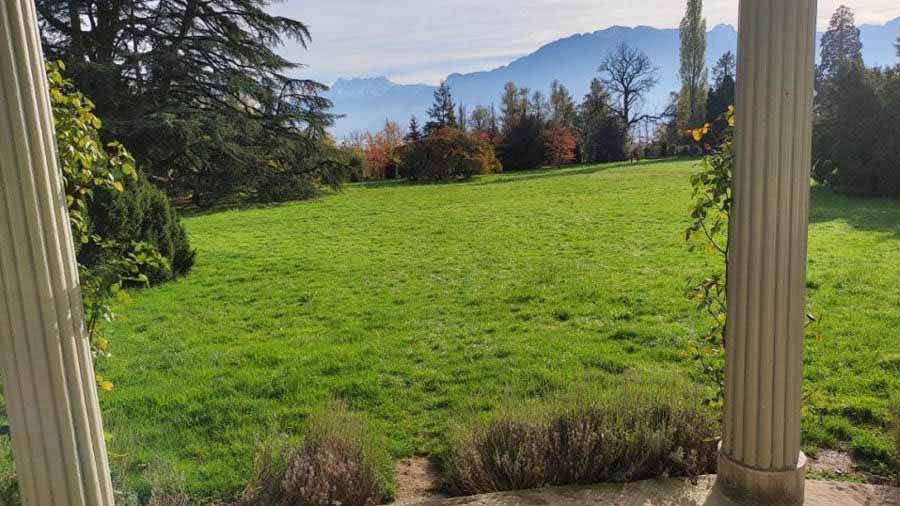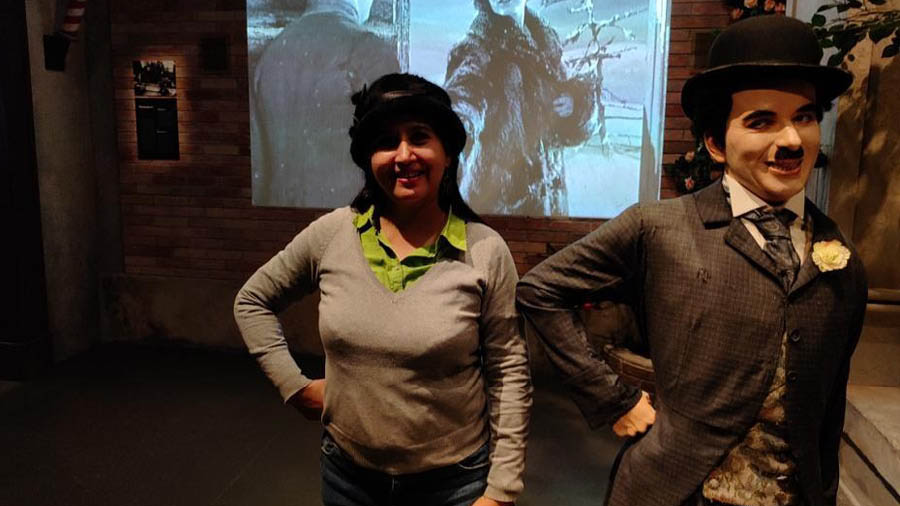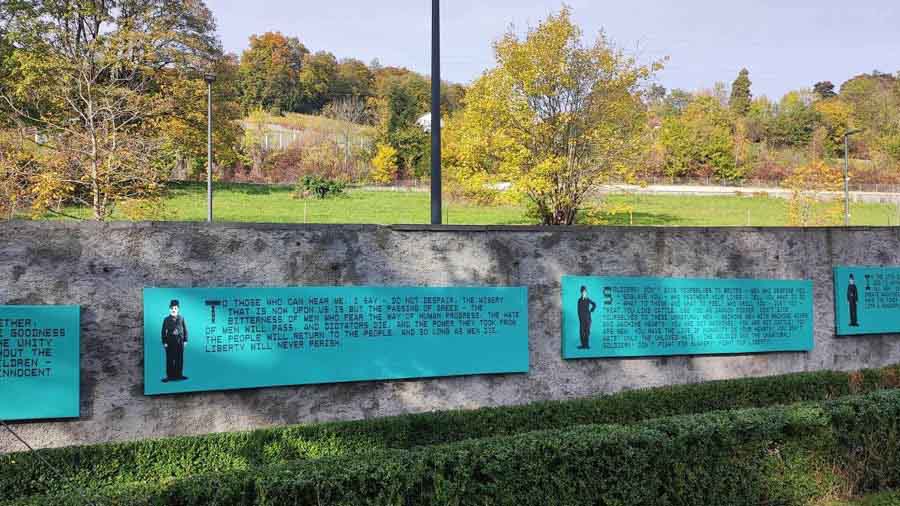“In that dark room in the basement of Oakley Street, Mother illuminated to me the kindliest light this world has ever known, which has endowed literature and the theatre with their greatest themes: love, pity and humanity.” — Charles Chaplin, My Autobiography
He has been called a genius by scientists, philosophers, writers, humanists, film-makers and actors. His films continue to fascinate generations. They are timeless in the true sense of the word. As children, we laughed at the slapstick and the physical humour in his films. As adults, we have learnt to appreciate the world view that lies behind some of his funniest films. Chaplin being sucked into the giant machine in Modern Times (1936) remains one of the indelible memories of childhood. Later in life, one came to appreciate the thought – the causes and consequences of the Great Depression (1929–39) – that went into the writing of the film.
Charlie Chaplin has been an important influence in Indian films. Take celebrated actor-director Raj Kapoor, for instance. Kapoor absorbed the mannerisms associated with Chaplin’s Little Tramp, including the waddle. It is a tribute to Chaplin’s genius that this Indian actor came to be universally recognised as the tramp, with his film Awara becoming a huge hit at home and abroad. Many actors after Kapoor, among them Sridevi (Mr India, 1987), Mehmood (Aulad, 1968), Kamal Haasan (Punnaigai Mannan, 1986) and Chiranjeevi (Chantabbai, 1986) channelised their inner Chaplin into their performances. But it was Noor Mohammed who first adopted the Chaplin persona, and even used the screen name ‘Charlie’ in films like The Indian Charlie (1933), Toofan Mail (1934) and Musafir (1940).
In November 2022, when I was informed that I would have to travel to Geneva for work, my first reaction was far from enthusiastic. Over the next four working days, I came to love Lake Geneva, the beautiful weather, the lovely architecture and the people. But the highlight of my trip was the last day, which I had taken off. It was sheer luck that I remembered reading about Chaplin spending the last 25 years of his life in Switzerland. I discovered in the nick of time that Corsier-sur-Vevey was less than a two-hour drive from Geneva. A quick booking of tickets on the Chaplin World website and I was off to the Chaplin Estate — Manor de Bain!
Taking in the sights and sounds of Charlie Chaplin’s estate
My heart started racing as I passed the town square in Vevey which had huge murals of Chaplin on some buildings. Finally, I entered the hallowed portals of the estate where Chaplin spent 25 years with his wife Oona and his children. Passing through his study in the main living quarters, as I entered the drawing room with its cosy sofas, I came across French windows which overlooked the massive grounds of the estate. I stopped to take a picture. Suddenly, my phone camera froze. I tried to close the camera app and switch off my phone, but nothing worked. Dejected, I moved into the dining room. I looked up to see a home video playing in a loop — of Chaplin enjoying a meal on a sunny day with family and friends. I thought to myself: Was this a sign? Was Chaplin saying, “You have come so far to see my home; I want you to enjoy my estate, look at my work. Slow down. Take it all in.”

Manor de Bain in Switzerland, where Chaplin spent the last 25 years of his life. Nirupama Kotru
I calmed down and went back to those French windows in the drawing room to take in the magnificent view of the estate grounds. A man walked towards me. I asked him if he could help unfreeze my phone. He suggested I switch it off and then on again. I did that, and voila! It worked. I realised that in those 10-15 minutes when my phone was frozen, I was forced to take a breather, to reflect upon the beauty I was surrounded by, and all the blessings which make life worth living.
As I emerged from the main building, I thought of rounding off the visit with a leisurely walk around the grounds. Suddenly I noticed a sign which said ‘The Studio’. There was a screen outside which said that a film screening was to start. I watched the film, a moving take on Chaplin’s life and work, with 10 other viewers.
After the film ended, we were asked to move towards the screen. Suddenly, the screen disappeared and lo and behold, I found myself on a beautifully recreated set from The Kid. We were prompted to go behind the set, and to my bewilderment, what followed was one set after another – The Great Dictator, City Lights, Gold Rush, Limelight, A King in New York, whew! It was such a delight to go through those sets, to see the wax figurines, to sit on the chair from The Gold Rush with Chaplin peeping from under a table, to pose next to Chaplin in my own bowler’s hat, to sit on the jail bench next to him, to be swallowed by the giant machine from Modern Times.

The author inside The Studio at Manor de Bain. Nirupama Kotru
During my visit and afterwards, I got a lot of time to reflect upon how Chaplin’s films were deeply concerned with the human condition, with all the miseries and challenges brought upon it by events that the common man has no control over. Chaplin’s work includes The Gold Rush (1925), which drew from real-life events such as the Klondike Gold Rush and the Donner Party, and The Great Dictator (1940), a satire on Adolf Hitler. Limelight (1952), which depicted the frustration of a has-been comedian, can be classified as auto-fiction as can The Kid (1921), while Modern Times has been hailed as an astute commentary on industrialisation. Levity was Chaplin’s forte, but all his films were deeply rooted in his political and social consciousness. More often than not, he had to pay a heavy price for sticking to his beliefs.
Recollecting the making of The Great Dictator, Chaplin says in his autobiography, ‘Halfway through making, I began receiving alarming messages from United Artists… But I was determined to go ahead, for Hitler must be laughed at. Had I known of the actual horrors of the German concentration camps, I could not have made The Great Dictator; I could not have made fun of the homicidal insanity of the Nazis.’

The boundary wall of the Manor de Bain. Nirupama Kotru
One who never shied away from speaking truth to power
Chaplin was a genius who understood the power of the audio-visual medium. Since pantomime was his greatest strength, having performed bit roles in theatres during his childhood days of great hardship and penury, he used this technique to convey pathos through humour. Although he was earning quite well as a comedian-writer-director in Hollywood, by 1919, he was so frustrated with the studio system, which did not give him a free hand to write his own scripts, that he co-founded United Artists along with Douglas Fairbanks, Mary Pickford and D.W. Griffith.
His first major hit under his own banner was The Kid, which drew from his childhood experiences. So strong were his convictions about the silent film that he swam against the tide and released City Lights in 1931, well after talkies had completely taken over Hollywood. Slowly, he started warming up to the possibilities of sound in film. He used sound effects in Modern Times but no spoken dialogue. He composed and sang a charming ditty in gibberish, Titine, with some random words in French, Italian and English thrown in, for Modern Times which never fails to bring a smile to the face, even 87 years after its release.
Whether it was silent films or talkies, Chaplin continued to tell his stories of universal values, of hope amidst great suffering. As an artist, he never shied away from speaking truth to power. Like most great artists, he did not accept manmade boundaries. Although he was English by birth, he was criticised for not fighting in World War I. He had long arguments with Winston Churchill about Mahatma Gandhi and the struggle of the Indian people for freedom. In fact, he met Gandhiji shortly after meeting Churchill, during a trip to London, and questioned him at length about his abhorrence for machinery.
He returned from the meeting with great admiration for Gandhiji’s strategies for achieving independence and his principles of non-violence and truth. His conversation with Gandhiji influenced his writing of Modern Times, especially the Gandhian theory about modernisation and rapid industrialisation being the cause of unemployment and rising inequality. The fearless artist once made an uncharitable remark about the English royalty, telling Churchill, “I thought socialists were opposed to a monarchy”, to which Winston Churchill replied, with a laugh, “If you were in England, we’d cut your head off for that remark.”
A pacifist and a philosopher who was derided for his views in America
Being wary of the ways of Hollywood where an artist was judged by his or her success at the box office, he made few friends in the film industry. Chaplin was happy spending time visiting his childhood haunts on his trips to London, and also enjoyed wining and dining with film stars, princes and princesses, prime ministers and presidents, scientists, philosophers, poets and writers. He was friends with Mary and Douglas Fairbanks, Albert Einstein, George Bernard Shaw, H.G. Wells, Harold Laski, Aldous Huxley, Theodore Dreiser, et al. He went to Lucerne in Switzerland to meet India’s first prime minister, Jawaharlal Nehru, expressing his surprise at finding him “a small man like myself”. Chaplin invited Pandit Nehru to his estate in Vevey for a meal. They had a long chat on the way, which left Chaplin impressed with the “…man of moods, austere and sensitive, with an exceedingly alert and appraising mind”.
Chaplin was a pacifist and a philosopher, and was derided for his views in America – not just mocked, but harassed by the FBI under its founding director J. Edgar Hoover. In 1952, the country which has historically been considered the land of free speech hounded Chaplin out of its borders under the mistaken impression that he was an avowed communist, and told him to never come back. Chaplin even narrowly escaped an assassination attempt in Japan.
Chaplin’s autobiography ends in 1964, on a poignant yet hopeful note, just like his films, with Chaplin expressing his sadness at having to leave America but also describing his happy days in Switzerland, where he befriended several artists who lived in the area. Eight years later, in 1972, Charles Spencer Chaplin was called back to America by the Academy of Motion Picture Arts & Sciences to receive an Honorary Oscar. After initial hesitation, Chaplin decided to attend the ceremony, which would end his 20-year exile from America. He went on to receive an unprecedented standing ovation lasting 12 minutes. Cries of “bravo!” filled the auditorium and Chaplin was clearly overwhelmed. It was an emotional homecoming for the man who had left Los Angeles in extremely unpleasant circumstances in 1952.
Chaplin was knighted by Queen Elizabeth II in 1975, but by then he was frail and had to accept the honour in a wheelchair. He passed away in 1977. I hope cine buffs like me keep rediscovering him, for The Tramp is timeless.
[Nirupama Kotru is a bureaucrat and has served in the I&B ministry as Director (Films). She is currently co-authoring an anthology on Hindi cinema of the 1970s]











